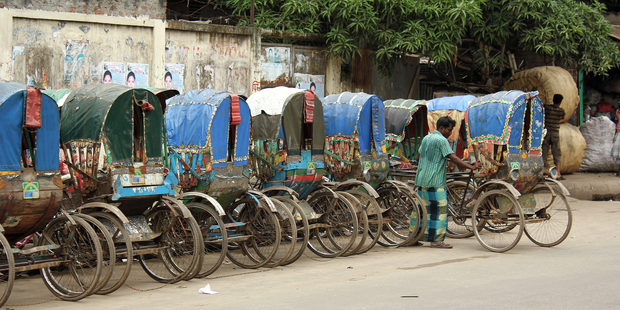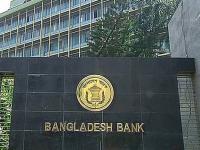By J.J. Somerset
So few tourists go to colourful Bangladesh that you’ll be spoiled, says J.J. Somerset – but you’ll also be amazed and enchanted.
Dhaka is one of the poorest, dirtiest, ugliest cities on the planet. You must go there at once. Tourists in Dhaka are so scarce they are treated like royalty. Bangla people swarm helpfully around tourists.
Many are curious, but mostly they come to translate, to give information and to ensure tourists are suitably attended.
Traffic police step into teeming traffic to help foreigners navigate busy thoroughfares. Bicycle rickshaw-wallahs take illegal shortcuts and are waved on when traffic wardens see they bear foreign passengers. When a tourist is thirsty, cha-wallahs emerge from the bustle of street merchants to supply tea.
Even though there are very few tourists, Dhaka’s infrastructure is much better than most LDCs (Least Developed Countries) thanks to a population of 14 million, a vibrant middle class and lucrative business opportunities for foreigners.
Travelling businesspeople are not good ambassadors for their countries.
They have heard that visiting Dhaka is a hardship and come prepared to find it. They are rude to waiters, complain loudly if their car is late and are terse with staff in the business centre.
In the elevators they speak of nothing but the appalling traffic and make it clear they do not want to eat ABC (Another Bloody Curry).
Meanwhile, the occasional tourists win the spoils. They have the city to themselves – tourist-wise – and can explore bazaars, museums, river life, mansions and forts unimpeded by the foreign hoi-polloi.
I was free to drift about the Ahsan Manzil (Pink Palace), imagining the lavish lifestyles of the Nawabs and Zamindars before they lost sovereignty to the British.
Sonargoan and Panam City, once flourishing trade links on the southwest Silk Road, were equally unimpeded, except for the clutch of middle-class Bangladeshis who surreptitiously clicked my photo, then scattered whenever I drew near.
There is wonder and discovery when you travel a city as a rare foreigner. At first you can hardly believe your luck and then you get addicted to being special. Everywhere you go, people treat you like a distinguished guest.
They gather around and want to talk. They offer to take you places, share stories and, like paparazzi, they can’t stop snapping your photo on their cellphones.
At one stage, as I beckoned a bicycle rickshaw-wallah, I counted 15 or so people around me.
There was the helpful man who had shown me the way to the Lalberg Fort, the man I had bought a drink from and his subordinate, the cricket man who was a fan of Dan Vettori, the ticket seller and his subordinate, the ticket collector and his subordinate, the historian who volunteered to guide me around the Fort, the uniformed guards; the rickshaw wallahs, an obliging translator and a considerate middle-aged man who stopped to cast a paternal eye over proceedings.
Travelling as a woman on your own in many Muslim countries can be uncomfortable – the men can be lascivious – but not in Dhaka.
The men (and women) are certainly watchful, but their interest is simply respectful curiosity. The only time I experienced any doubt about someone’s intentions was when a man inspected me a little more keenly than most. After walking past, he turned and came up quite close to me.
I was unsure what he was about but, because he caught me off guard, I meekly watched as he gently freed my orna (long scarf) from where it had become snared on a bamboo strut at the back of my rickshaw. He then smiled, a little too broadly perhaps, and continued on his way.
At times in Dhaka, particularly in the old city, in poorer parts of town and at construction sites, you feel as if you have gone back in time.
Equipment is manual, ropes and pulleys are common and produce is weighed on large iron scales. Instead of machines and computers, people do the work so everything takes longer, a feature which adds quality to daily life.
When you want braid or ribbon sewn on to newly purchased textiles, men will sew it on trestle sewing machines that line the alleyways of bazaars.
Fairground attractions such as carousels and miniature Ferris wheels are also manually operated. Men climb the struts and use weight and momentum to turn the Ferris wheels. The rides are painstakingly hand-painted.
Everything is colourful. Bangladesh’s legendary textiles festoon the city.
The array of colours and designs is so overwhelming it is difficult to choose. Stalls in markets – where things are so inexpensive it is unnecessary to consult your wallet before you purchase – are decorated and painted with seeming frivolity. Women are dressed in beautiful salwar kameezes and saris of every colour except black.
Dhaka bicycle rickshaws are famous for their delightfully gaudy art. To be caught in a bicycle-rickshaw traffic jam is reason enough to visit Dhaka.
With 600,000 rickshaws competing for space in narrow lanes and alleyways, it is not hard to get into a snarl-up.
It is fascinating to sit back and observe the intricate, often idiosyncratic, rules of the road. For instance, if you motion with your hand that you are absolutely coming through, there will be deference … except when there isn’t.
Luckily, the collision is only minor as speeds are low and drivers do not fret over small clashes.
There is no such thing as road rage in Dhaka and there is always food to help salve stressful situations.
Bangla food is rich with spices that have long been celebrated overseas. Apparently, 90 per cent of London’s Indian restaurants are Bangladeshi.
Starting the day with melt-in-your-mouth masala dosa and then moving on to mutton bhuna, green Bengal chicken, paneer jhalfrazie and fish in mustard sauce is one hell of a way to dine.
The only drawback to this fairy tale is poverty. The IMF ranks Bangladesh as the 155th poorest country out of 183 but you don’t need IMF figures to tell you that.
It’s clear that this country is poor. It is also dirty. When the rains come, the dirt paths and roads turn to mud and then to floods.
Hard-to-find guidebooks to Bangladesh tell you not to go to Dhaka during the monsoon.
But go there. Soon.
CHECKLIST
Getting there: Singapore Airlines flies from Auckland to Dhaka via Singapore every day. The Singapore to Dhaka leg is about a four-hour flight.
Where to stay: The Westin Dhaka (a five- star hotel).
What to do: Visit Ahsan Manzil (Pink Palace); New Market; Hindu Street; DCC Antiques Market and Gulshan 2.
Top tip: Take traveller’s cheques – getting cash at ATMs and banks is not easy.
Source: NZ Herald











I have seen other poorer,dirtier uglier cities on this planet than Dhaka, but certainly not as friendly to tourists as ours.